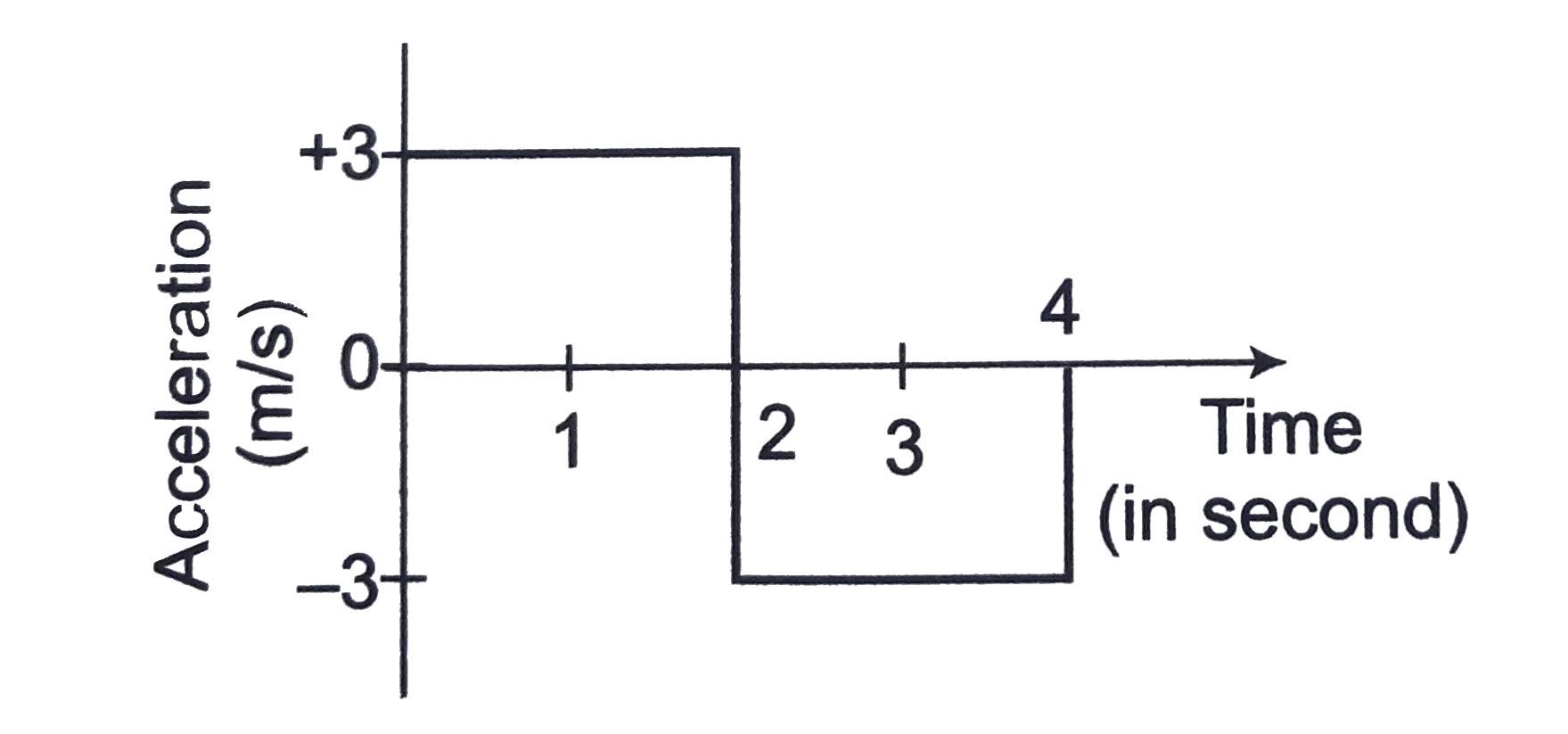Starting from rest, the acceleration of a particle is a=2(t-1). The velocity of the particle at t=5s is :-
At t=2s, the position of the particle is at x=9m
Particle acceleration at t=2s is 1m/s2
Particle acceleration is 1/2m/s2 through out the motion
Particle will never go in negative direction from it's starting position
The correct Answer is:A, C, D
To find the velocity of a particle at t=5 seconds given that its acceleration is a=2(t−1) and it starts from rest, we can follow these steps:
Step 1: Understand the relationship between acceleration, velocity, and time.
The acceleration a is the derivative of velocity v with respect to time t:
a=dvdt
Thus, we can express the velocity as the integral of acceleration:
v=∫adt+C
Step 2: Substitute the expression for acceleration.
Given a=2(t−1), we substitute this into the integral:
v=∫2(t−1)dt+C
Step 3: Perform the integration.
Integrating 2(t−1):
v=2(t22−t)+C=t2−2t+C
Step 4: Determine the constant of integration C.
Since the particle starts from rest, we know that at t=0, the velocity v=0:
v(0)=02−2(0)+C=0⟹C=0
Thus, the velocity function simplifies to:
v=t2−2t
Step 5: Calculate the velocity at t=5 seconds.
Now, we substitute t=5 into the velocity equation:
v(5)=52−2(5)=25−10=15m/s
Conclusion:
The velocity of the particle at t=5 seconds is 15m/s.
---
The acceleration a is the derivative of velocity v with respect to time t:
a=dvdt
Thus, we can express the velocity as the integral of acceleration:
v=∫adt+C
Given a=2(t−1), we substitute this into the integral:
v=∫2(t−1)dt+C
Integrating 2(t−1):
v=2(t22−t)+C=t2−2t+C
Since the particle starts from rest, we know that at t=0, the velocity v=0:
v(0)=02−2(0)+C=0⟹C=0
Thus, the velocity function simplifies to:
v=t2−2t
Now, we substitute t=5 into the velocity equation:
v(5)=52−2(5)=25−10=15m/s
The velocity of the particle at t=5 seconds is 15m/s.
Topper's Solved these Questions
- MOTION IN A PALNEBOOK - ALLENCHAPTER - MOTION IN A PALNEEXERCISE - EXERCISE-03
6 Videos
- MOTION IN A PALNEBOOK - ALLENCHAPTER - MOTION IN A PALNEEXERCISE - Assertion-Reason
20 Videos
- MOTION IN A PALNEBOOK - ALLENCHAPTER - MOTION IN A PALNEEXERCISE - SOLVED EXAMPLE
28 Videos
- KINEMATICS-2DBOOK - ALLENCHAPTER - KINEMATICS-2DEXERCISE - Exercise (O-2)
46 Videos
- NEWTON'S LAWS OF MOTION & FRICTIONBOOK - ALLENCHAPTER - NEWTON'S LAWS OF MOTION & FRICTIONEXERCISE - EXERCISE (JA)
4 Videos
Similar Questions
Starting from rest, the acceleration of a particle is a=2(t−1). The velocity (i.e.v=∫ a dt ) of the particle at t=10 s is :-
View SolutionA particle starts from rest and moves with an acceleration of a={2+|t−2|}m/s2 The velocity of the particle at t=4 sec is
View SolutionA particle starts from rest and moves with an acceleration of a={2+|t−2|}m/s2 The velocity of the particle at t=4 sec is
View SolutionThe acceleration of a'particle starting from rest, varies with time according to the relation a=kt+c. The velocity of the particle after time t will be :
View SolutionThe acceleration of a particle which starts from rest varies with time according to relation a=2t+3. The velocity of the particle at time t would be
View SolutionIf a=(3t2+2t+1) ms2 is the expression according to which the acceleration of a particle varies. Then-
Find displacement of the particle after 2 seconds of start.
View SolutionIf a=(3t2+2t+1) ms2 is the expression according to which the acceleration of a particle varies. Then-
Q. Find displacement of the particle after 2 seconds of start.
View SolutionA particle starts from rest at t=0 and moves in a straight line with an acceleration as shown below. The velocity of the particle at t=3 s is

View SolutionThe acceleration a of a particle starting from rest varies with time according to relation, a=αt+β. Find the velocity of the particle at time instant t.
Strategy : a=dvdt
View SolutionA particle is moving with a velocity of v=(3+6t+9t2)ms. Find out
(a) the acceleration of the particle at t=3s.
(b) the displacement of the particle in the interval t=5s to t=8s.
View Solution
